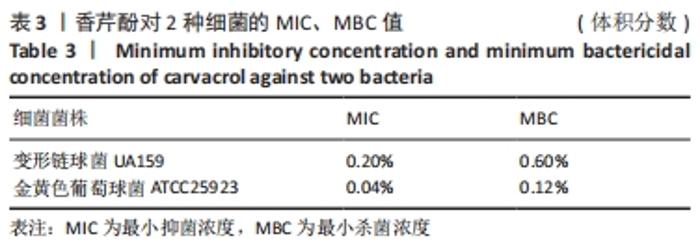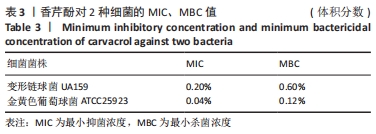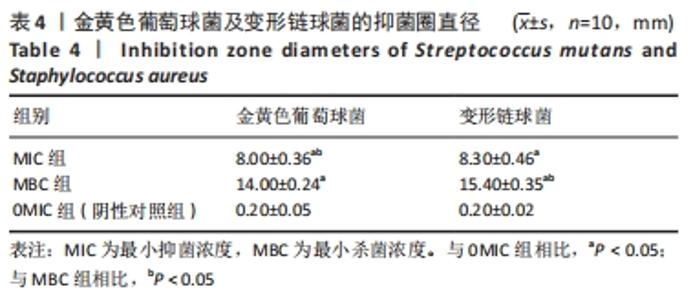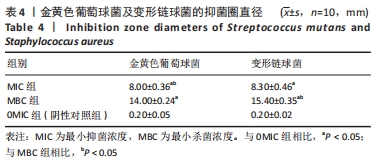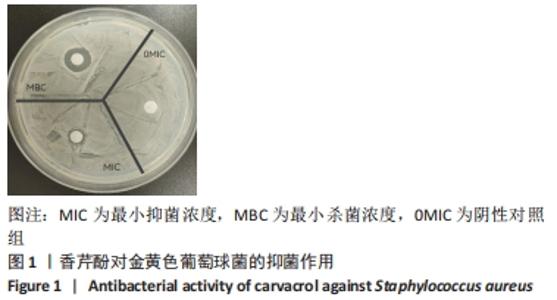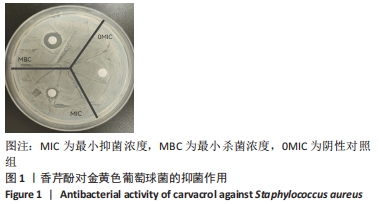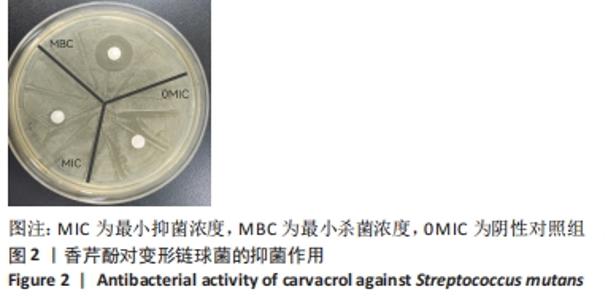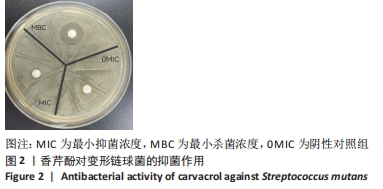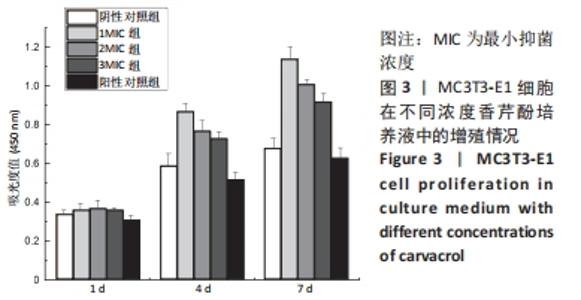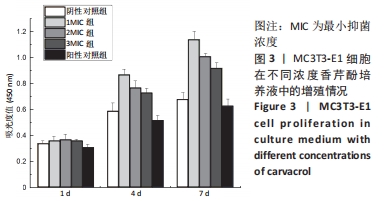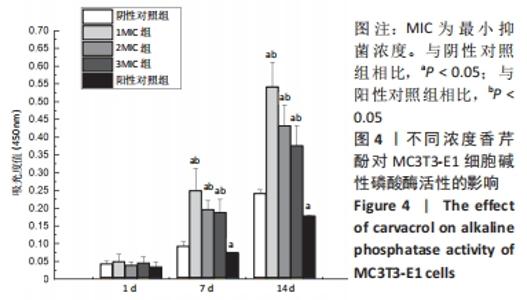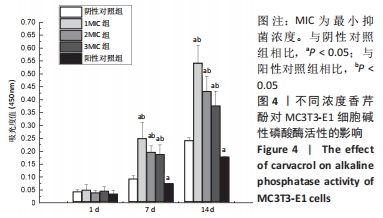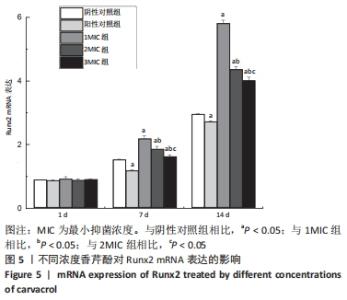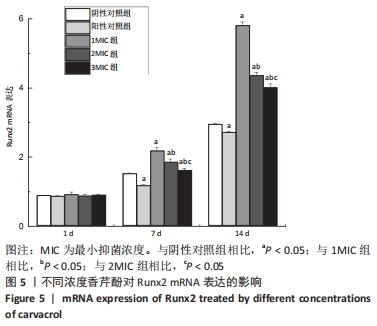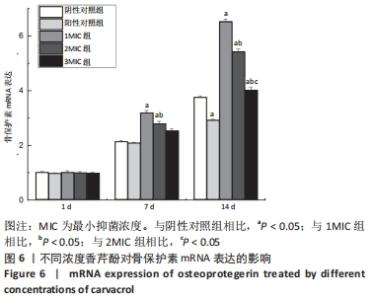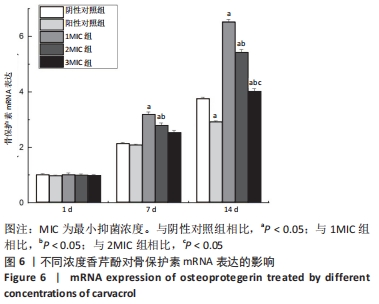Chinese Journal of Tissue Engineering Research ›› 2023, Vol. 27 ›› Issue (11): 1765-1771.doi: 10.12307/2023.124
Previous Articles Next Articles
Effects of carvacrol on osteoblasts and common oral pathogens
Zhang Zihan, Wang Wenli, Li Jinnuo, Li Yourui
- Affiliated Hospital of Binzhou Medical University, Binzhou 256603, Shandong Province, China
-
Received:2022-03-14Accepted:2022-05-13Online:2023-04-18Published:2022-09-26 -
Contact:Li Yourui, MD, Associate chief physician, Affiliated Hospital of Binzhou Medical University, Binzhou 256603, Shandong Province, China -
About author:Zhang Zihan, Master candidate, Affiliated Hospital of Binzhou Medical University, Binzhou 256603, Shandong Province, China -
Supported by:Shandong Medical and Health Development Project, No. 2017WS753 (to LYR); Binzhou Medical University Science and Technology Project, No. BY2016KJ006 (to LYR)
CLC Number:
Cite this article
Zhang Zihan, Wang Wenli, Li Jinnuo, Li Yourui. Effects of carvacrol on osteoblasts and common oral pathogens[J]. Chinese Journal of Tissue Engineering Research, 2023, 27(11): 1765-1771.
share this article
Add to citation manager EndNote|Reference Manager|ProCite|BibTeX|RefWorks
| [1] 薛元泰,吴世芳,李义恒,等.8种精油对乳酸菌及致病菌的选择抑制性筛选及其应用研究[J].食品与发酵工业:1-11[2022-04-25]. [2] FACHINI-QUEIROZ FC, KUMMER R, ESTEVÃO-SILVA CF, et al. Effects of Thymol and Carvacrol, Constituents of Thymus vulgaris L. Essential Oil, on the Inflammatory Response. Evid Based Complement Alternat Med. 2012;2012:657026. [3] 许璐,喻毅,曹宇,等.牛至油及其主要成分的体外抑菌实验[J].世界中医药,2020,15(14):2072-2075. [4] BNYAN IA, ABID AT, OBIED HN. Antibacterial Activity of Carvacrol against Different Types of Bacteria. J Nat Sci Res. 2014;4(9):12-16. [5] ČABARKAPA IS, ŠKRINJAR MM, LEVIĆ JD, et al. Influence of thymol and carvacrol on initial cell attachment and biofilm of Candida albicans. Food Feed Res. 2015;42(1):23-30. [6] MILADI H, ZMANTAR T, KOUIDHI B, et al. Synergistic effect of eugenol, carvacrol, thymol, p-cymene and γ-terpinene on inhibition of drug resistance and biofilm formation of oral bacteria. Microb Pathog. 2017; 112:156-163. [7] KOUIDHI B, ZMANTAR T, HENTATI H, et al. Cell surface hydrophobicity, biofilm formation, adhesives properties and molecular detection of adhesins genes in Staphylococcus aureus associated to dental caries. Microb Pathog. 2010;49(1-2):14-22. [8] KOUKOS G, SAKELLARI D, ARSENAKIS M, et al. Prevalence of Staphylococcus aureus and methicillin resistant Staphylococcus aureus (MRSA) in the oral cavity. Arch Oral Biol. 2015;60(9):1410-1415. [9] MERGHNI A, BEN NEJMA M, DALLEL I, et al. High potential of adhesion to biotic and abiotic surfaces by opportunistic Staphylococcus aureus strains isolated from orthodontic appliances. Microb Pathog. 2016; 91: 61-67. [10] CIANDRINI E, CAMPANA R, FEDERICI S, et al. In vitro activity of Carvacrol against titanium-adherent oral biofilms and planktonic cultures. Clin Oral Investig. 2014;18(8):2001-2013. [11] VERARDI G, CENCI MS, MASKE TT, et al. Antiseptics and microcosm biofilm formation on titanium surfaces. Braz Oral Res. 2016;30:S1806-83242016000100220. [12] VU AA, BOSE S. Natural Antibiotic Oregano in Hydroxyapatite-Coated Titanium Reduces Osteoclastic Bone Resorption for Orthopedic and Dental Applications. ACS Appl Mater Interfaces. 2020;12(47):52383-52392. [13] DEEPAK V, KASONGA A, KRUGER MC, et al. Carvacrol Inhibits Osteoclastogenesis and Negatively Regulates the Survival of Mature Osteoclasts. Biol Pharm Bull. 2016;39(7):1150-1158. [14] KUO PJ, HUNG TF, LIN CY, et al. Carvacrol Ameliorates Ligation-Induced Periodontitis in Rats. J Periodontol. 2017;88(7):e120-e128. [15] 邢承宇,王璐,陈星光,等.香芹酚-壳聚糖纳米颗粒的制备及抑菌活性研究[J].食品与发酵工业:1-10[2022-04-25]. [16] DE L GUIMARÃES LG, DA SILVA ML, REIS PC, et al. General Characteristics, Phytochemistry and Pharmacognosy of Lippia sidoides. Nat Prod Commun. 2015;10(11):1861-1867. [17] TUFEKCI E, CASAGRANDE ZA, LLNDAUER SJ, et al. Effectiveness of an essential oil mouthrinse in improving oral health in orthodontic patients. Angle Orthod. 2008;78:294-298. [18] LANA-RUIZ-CABELLO M, MAISANABA S, PUERTO M, et al. Evaluation of the mutagenicity and genotoxic potential of carvacrol and thymol using the Ames Salmonella test and alkaline, Endo III- and FPG-modified comet assays with the human cell line Caco-2. Food Chem Toxicol. 2014;72:122-128. [19] AMINI P, ARAUJO MW, WU MM, et al. Comparative antiplaque and antigingivitis efficacy of three antiseptic mouthrinses: a two week ran-domized clinical trial. Braz Oral Res. 2019;23:319-325. [20] GIANNELLI M, CHELLINI F, MARGHERI M, et al. Effect of chlorhexidine digluconate on different cell types: a molecular and ultrastructural investigation. Toxicol In Vitro. 2008;22(2):308-317. [21] RODRIGUEZ HERRERO E, BOON N, PAUWELS M, et al. Necrotrophic growth of periodontopathogens is a novel virulence factor in oral biofilms. Sci Rep. 2017;7(1):1107. [22] AHMAD A, KHAN A, AKHTAR F, et al. Fungicidal activity of thymol and carvacrol by disrupting ergosterol biosynthesis and membrane integrity against Candida. Eur J Clin Microbiol Infect Dis. 2011;30(1):41-50. [23] 甘盈盈,袁中伟,张天翼,等.香芹酚对耐甲氧西林金黄色葡萄球菌(USA300)抑菌机制的研究[J].四川农业大学学报,2019,37(2): 276-282. [24] BEN ARFA A, COMBES S, PREZIOSI-BELLOY L, et al. Antimicrobial activity of carvacrol related to its chemical structure. Lett Appl Microbiol. 2006;43(2):149-154. [25] MILADI H, ZMANTAR T, KOUIDHI B, et al. Use of carvacrol, thymol, and eugenol for biofilm eradication and resistance modifying susceptibility of Salmonella enterica serovar Typhimurium strains to nalidixic acid. Microb Pathoge. 2017;104:56-63. [26] 戴雨芸,李超,袁中伟,等.香芹酚抑制金黄色葡萄球菌生物被膜的形成[J].微生物学通报,2020,47(3):813-820. [27] GARVEY MI, RAHMAN MM, GIBBONS S, et al. Medicinal plant extracts with efflux inhibitory activity against Gram-negative bacteria. Int J Antimicrob Agents. 2011;37(2):145-151. [28] CHOUHAN S, SHARMA K, GULERIA S. Antimicrobial Activity of Some Essential Oils-Present Status and Future Perspectives. Medicines (Basel, Switzerland). 2017;4(3):E58. |
| [1] | Tang Liang, Li Xiheng, Niu Ruijuan, Li Xinyue, Zou Xinying, Mao Tianjiao, Li Jiang. Naringin regulates the function of RAW264.7 macrophages to affect the osteogenic differentiation of MC-3T3-E1 cells [J]. Chinese Journal of Tissue Engineering Research, 2023, 27(8): 1205-1210. |
| [2] | Xu Xingxing, Wen Chaoju, Meng Maohua, Wang Qinying, Chen Jingqiao, Dong Qiang. Carbon nanomaterials in oral implant [J]. Chinese Journal of Tissue Engineering Research, 2023, 27(7): 1062-1070. |
| [3] | Tang Haotian, Liao Rongdong, Tian Jing. Application and design of piezoelectric materials for bone defect repair [J]. Chinese Journal of Tissue Engineering Research, 2023, 27(7): 1117-1125. |
| [4] | Qin Yuxing, Ren Qiangui, Li Zilong, Quan Jiaxing, Shen Peifeng, Sun Tao, Wang Haoyu. Action mechanism and prospect of bone microvascular endothelial cells for treating femoral head necrosis [J]. Chinese Journal of Tissue Engineering Research, 2023, 27(6): 955-961. |
| [5] | Zhang Min, Zhang Xiaoming, Liu Tongbin. Application potential of naringin in bone tissue regeneration [J]. Chinese Journal of Tissue Engineering Research, 2023, 27(5): 787-792. |
| [6] | Zhang Lichen, Chen Liang, Gu Yong. Inorganic ion bionic periosteum regulates immune microenvironment to promote bone repair [J]. Chinese Journal of Tissue Engineering Research, 2023, 27(3): 346-353. |
| [7] | Chen Feng, Ren Guowu, Zhang Xiaoyun, Chen Yueping, Shi Rusheng. Receptor activator of nuclear factor-kappa B ligand signal transduction mechanism and osteoclast activation [J]. Chinese Journal of Tissue Engineering Research, 2023, 27(2): 293-299. |
| [8] | Zhang Jie, Tian Ai. Advances in the signaling pathway of M2 macrophages involved in bone regeneration [J]. Chinese Journal of Tissue Engineering Research, 2023, 27(2): 314-321. |
| [9] | Luo Di, Liang Xuezhen, Yan Bozhao, Li Jiacheng, Xu Bo, Li Gang. Mechanism of Bushen Huoxue Capsule in repair of bone defects due to steroid-induced osteonecrosis of the femoral head in rats [J]. Chinese Journal of Tissue Engineering Research, 2023, 27(2): 184-191. |
| [10] | Wei Tengfei, He Xiaoming, Wei Yurou, Zhan Zhiwei, He Mincong, He Wei, Wei Qiushi. Differential expression of Piezo1 in osseous tissue of steroid- and alcohol-induced osteonecrosis of the femoral head [J]. Chinese Journal of Tissue Engineering Research, 2023, 27(2): 270-275. |
| [11] | Huang Yanni, Yang Hua, Yang Dongmei, Hu Xulin, Gao Hong, Huang Yina. Rat bone defect repaired with polytrimethylene carbonate/beta-tricalcium phosphate microsphere scaffold [J]. Chinese Journal of Tissue Engineering Research, 2023, 27(12): 1856-1862. |
| [12] | Yao Xiaoling, Peng Jiancheng, Xu Yuerong, Yang Zhidong, Zhang Shuncong. Variable-angle zero-notch anterior interbody fusion system in the treatment of cervical spondylotic myelopathy: 30-month follow-up [J]. Chinese Journal of Tissue Engineering Research, 2022, 26(9): 1377-1382. |
| [13] | Wang Jing, Xiong Shan, Cao Jin, Feng Linwei, Wang Xin. Role and mechanism of interleukin-3 in bone metabolism [J]. Chinese Journal of Tissue Engineering Research, 2022, 26(8): 1260-1265. |
| [14] | Kang Kunlong, Wang Xintao. Research hotspot of biological scaffold materials promoting osteogenic differentiation of bone marrow mesenchymal stem cells [J]. Chinese Journal of Tissue Engineering Research, 2022, 26(4): 597-603. |
| [15] | Li Hui, Chen Lianglong. Application and characteristics of bone graft materials in the treatment of spinal tuberculosis [J]. Chinese Journal of Tissue Engineering Research, 2022, 26(4): 626-630. |
| Viewed | ||||||
|
Full text |
|
|||||
|
Abstract |
|
|||||
